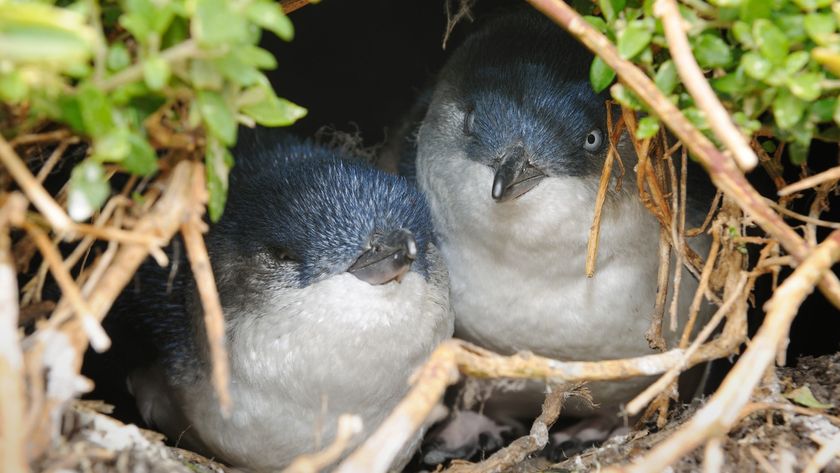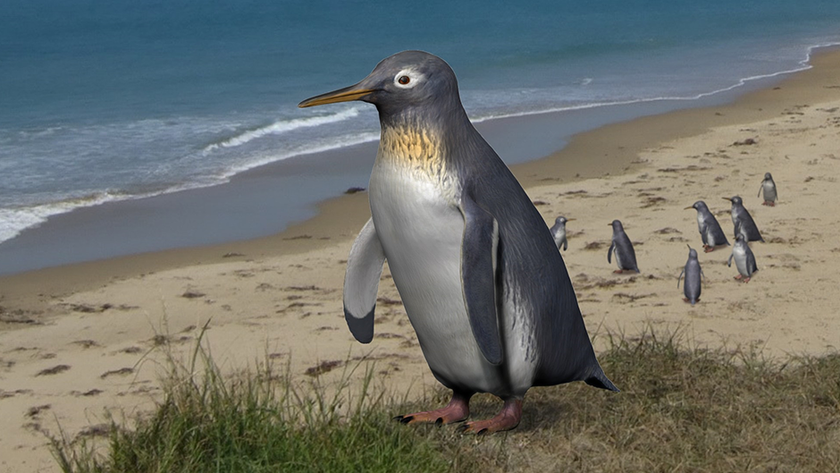
Earth's Penguins Skating on Thin Ice
If the harrowing plight of emperor penguins portrayed in the film "March of the Penguins" looked bad, it's nothing compared with the dire straits faced by many other penguin species.
Of the 18 penguin species on Earth, 13 are considered either threatened or endangered, with some species on the brink of extinction. Experts gathered last week to discuss the situation at the International Penguin Conference at the New England Aquarium in Boston. [See all 18 penguin species.]
"I hope that people will hear the word that they are in trouble, the oceans are in trouble," said Heather Urquhart, manager of the New England Aquarium's penguin exhibit and organizer of the conference. "I hope we get together and make some changes and hopefully stem the tide of what's going on with these species."
Penguins are non-flying, aquatic birds that live exclusively in the Southern Hemisphere.
"They occupy a niche fairly unexplored by other bird species," Urquhart told OurAmazingPlanet. "They evolved from birds of flight, and evolved not to fly so they could exploit the ocean resources that flying seabirds couldn't get to. Many species spend 80 percent of their lives at sea."
Austere life
Emperor penguins are the largest of the penguin species, and mate and breed on the ice of Antarctica. They make a harrowing trek across up to 75 miles (120 kilometers) of ice to reach breeding colonies during the frigid Antarctic winter, and after chicks are born males and females take turns diving for food and caring for the young.
Sign up for the Live Science daily newsletter now
Get the world’s most fascinating discoveries delivered straight to your inbox.
While this life can be rather austere, for now it is sustaining: Emperor penguins are rated of least concern on the International Union for Conservation of Nature (IUCN) Red List of Threatened Species.
"I think they're faring a lot better than some other species," said conference presenter Gerry Kooyman, a biologist at the Scripps Institution of Oceanography at the University of California-San Diego who studies emperor penguins. "The massive amount of Antarctic ice is a buffer; it adds some level of stability. Even though some of the ice is declining, there's a much greater buffer of ice there than in the Arctic."
On the brink
Not faring so well are species such as erect-crested penguins, a New Zealand native that has lost about 70 percent of its population over the last 20 years.
The Galápagos penguin, endemic to the Galápagos Islands around the equator in the Pacific Ocean, has experienced a population decline of over 50 percent since the 1970s, and faces a 30-percent chance of extinction in this century, said Tony LaCasse, spokesman for the New England Aquarium.
"One big incident could wipe out that population," Urquhart said.
Other species like the yellow-eyed penguin of New Zealand, and the northern rockhopper penguin that breeds on islands in the southern Atlantic Ocean, are also endangered (the latter has declined by 90 percent over the last 50 years, according to a 2009 paper in the journal Bird Conservation International).
African penguins, a once robust iconic species in Namibia and South Africa, have experienced a precipitous decline and were recently reclassified as endangered.
"It's a very disturbing sign that that should happen in a species that was once so abundant, and it's occurring right before our eyes," Kooyman said.
Hit from all sides
The reasons for these declines vary according to species, with some penguins being hit from all sides by multiple threats.
Common dangers to penguin survival are pollution and human appropriation of habitats, as well as new mammalian predators such as dogs, cats and weasels that have been introduced by humans to penguins' environments. Some penguins are caught as bycatch by commercial fishers, and others are starving because fisheries are harvesting most of the prey available to penguins. Oil dumping and algae blooms in the oceans are also wreaking havoc on their food supply and habitats.
Finally, and in many cases most importantly, climate change is radically altering many penguins' habitats, affecting ocean temperatures and reducing the amount of sea ice. The changes result in limited space available for penguin breeding and a diminishing supply of krill, the small crustaceans that dominate many penguins' diets and which require sea ice cover to spawn.
Not only is this bad news for penguins, but it could spell disaster for the larger ecosystem around them.
"They're kind of the sentinel, or the canary in the coal mine, for the ocean in general," Urquhart said. "They can show us some things that are happening to the ocean environment."
While awareness of penguins' plight is growing and efforts are underway to aid the animals, a major reversal in human consumption and environmental interference could be necessary to save some penguin species, scientists said.
- 10 Species You Can Kiss Goodbye
- 8 of the World's Most Endangered Places
- Why Don't Penguin Feet Freeze on Ice?
Clara Moskowitz is a senior writer for LiveScience, a sister site to OurAmazingPlanet.
This article was provided by OurAmazingPlanet, a sister site to LiveScience.












